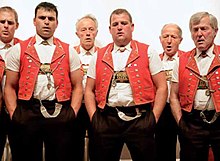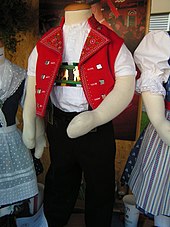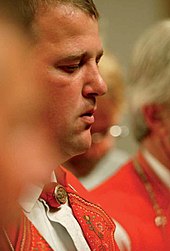Toggenburg costumes
The Toggenburg in eastern Switzerland Canton of St. Gallen has four costumes for men and three for women. Together with the very similar Appenzell alpine costume, the Toggenburg alpine costume is one of the most famous traditional costumes in Switzerland . Wearing the traditional costume , the festival costume and the weekday garment is still a lively folk custom today without the support of traditional costume associations . These traditional costumes are worn when moving up and down the Alps , at cattle shows, on festive days and by yodelling choirs .
history
The folk costumes developed in the course of the 17th and 18th centuries based on the fashions of the urban bourgeoisie and the rural patriciate . While at the turn of the 18th to the 19th century the urban bourgeoisie exchanged the frilled collar for the simple bourgeois skirt, the national costumes were in full bloom. Yellow trousers were already known in Swabia in the 17th century , but before 1800 they were still unknown in Appenzellerland . The dragoons of the Abbey of St. Gall , the city of St. Gallen , the state of Zurich and Württemberg rode before the turn of the century with yellow pants. In 1807 it is proven that considerable sums of money were spent on lederhosen in Appenzellerland. Research into traditional costumes gives no indication of whether the farmers wore military trousers that had been discarded. But where did the uniform stocks go after the French invasion of 1798/99? As early as 1797, there is evidence that a velvet breast cloth cost more in Toggenburg than a pair of lederhosen.
In the first half of the 19th century, industrialization changed living conditions and culture and traditional clothing disappeared. In the course of the 19th century, women's clothing developed into modesty with a tendency towards Biedermeier . The missing Toggenburg women's costume was renewed around 1925 as part of the Swiss traditional costume movement . The Toggenburg herdsman costume, on the other hand, defied all fashion trends in the middle and upper Toggenburg and remained uninterrupted.
Men's costumes
Toggenburg alpine costume
An important part of the herdsman's costume is the red, hand-embroidered and open breast cloth, a gilet made of red wool with flat silver buttons. The yellow breeches made of goatskin or foal leather do not have a fly, but a square bib, which is closed with buttons on the waistband (“loading pants”). Around 1750 the Prussian Army replaced the fly with a bib. Sheer cloth printed in color is worn over the left hip.
The shirt ("Chüelihemd") made of white cotton is embroidered in the front center with Alpfahrt and ornaments. The black, leather suspenders are covered with intricately chased brass ornaments. The men wear a black flat hat made of felt with a filigree rose hat in the front center, the boys wear a black leather cap. When traveling to the Alps, the herdsmen wear a fresh wreath of flowers on the left side of their hat if possible. White hand-knitted knee socks and alpine shoes with leather tabs and silver buckles complete the costume.
As jewelry, the herdsman wears a snake's head with a Schueffe (ladle) (Schumer), a gold-plated tie brooch, a chain of trousers hanging down on the right, a silver herdsman's ring on his left hand and, if necessary, a herdsman's whistle with silver jewelry.
This costume only differs from the Appenzell alpine costume in details . The silver necklace is only worn in Toggenburg, not in Appenzellerland. There are other differences in the embroidery decorations. In Toggenburg some of the braces have fringes, but never in the two half-cantons.
Toggenburg festival costume
The brown trousers of the "Tüechligwand", as the festive costume is also called, are lined and made of wool. Her trouser shop is wider than the yellow breeches in herdsman's costume. A shepherd's cloth is not available, otherwise the festive costume corresponds to the Toggenburg herdsman's costume.
Toggenburg Sunday gwand
The Sunday gwand consists of a brown gilet, a brown smock , a white "Chüelihemd", black suspenders with brass ornaments, brown trousers with a drawer clasp, black flat hat with hat rose, white socks and heather shoes. A watch chain with a pocket watch serves as jewelry .
Toggenburg weekday gwand
Components of the weekday garment are a Tschopen made of yellow Zwilch ("Fueterschlutte" or "Zwilchtschoope"), or an overcoat made of yellow Zwilch with a heart in the middle, a gray cardigan or black cardigan made of plush and an edelweiss shirt from Barchent .
Women's costumes
Toggenburg Sunday costume
The Sunday costume consists of a black bonnet, a white blouse made of fine linen or half- linen fabric, an arm chain, a bodice made of the same black wool serge as the skirt, the skirt, an apron made of plain, dark taffeta silk , knitted white cotton stockings and traditional shoes with silver buckles .
In winter, the Sunday costume can be complemented with a long-sleeved jacket made of black wool serge like a skirt and bodice. The Toggenburg mourning costume is the winter Sunday costume to which the women wear a black woolen fichu and a black damask apron.
Toggenburg Tschöpplitracht
The Tschöpplitracht includes a skirt made of worsted wool in the colors blue, green, brown or black, a white blouse, a Tschopen made of the same material as the skirt, an apron with a striped pattern along the length and a white fichu. Headgear was never worn, but white stockings and black traditional shoes.
Festival costume in Untertoggenburg
The Untertoggenburg festival costume consists of a black cap, a skirt made of pure wool in dark colors, a bodice made of the same cloth as the skirt, a white blouse, a finely patterned apron, white stockings and black traditional shoes.
Individual evidence
- ↑ a b The costume, the dress of home. On the website of the St. Gallische Trachtenvereinigung, accessed on August 1, 2019
- ↑ a b c d Jost Kirchgraber: The rural Toggenburg house and its culture in the upper Thur and Neckertal in the period between 1648 and 1798 . VGS Verlagsgenossenschaft, St. Gallen 1990, ISBN 978-3-7291-1056-4 , p. 82-83 .
- ↑ a b The Toggenburg costume. Information sign in the Toggenburg Museum Lichtensteig, visited on July 25, 2019
- ↑ a b c d Toggenburg alpine costume. On the website of the St. Gallische Trachtenvereinigung, accessed on August 1, 2019
- ↑ The herdsman's costume. Information sign in the Toggenburg Museum Lichtensteig, visited on July 25, 2019
- ↑ Johannes Wey: Historical eye-catcher. In: St. Galler Tagblatt (online) of October 5, 2011
- ↑ Sara Leu: Connection: Trachten make Appenzeller. In: St. Galler Tagblatt (online) from July 15, 2017
- ↑ Sennegroscht and Sennenschmuck. The Toggenburg alpine costume. On the Alpwirtschaft aktuell website (www.alpkataster.ch) of the Agricultural Center of the Canton of St. Gallen
- ↑ Toggenburg festival costume. On the website of the St. Gallische Trachtenvereinigung, accessed on August 1, 2019
- ↑ Toggenburger Sonntigsgwand. On the website of the St. Gallische Trachtenvereinigung, accessed on August 1, 2019
- ↑ Toggenburger Werchtigsgwand. On the website of the St. Gallische Trachtenvereinigung, accessed on August 1, 2019
- ↑ The Sunday costume of women. Information sign in the Toggenburg Museum Lichtensteig, visited on July 25, 2019
- ↑ Toggenburg Sunday costume. On the website of the St. Gallische Trachtenvereinigung, accessed on August 1, 2019
- ^ Toggenburg winter Sunday costume and Toggenburg mourning costume. On the website of the St. Gallische Trachtenvereinigung, accessed on August 1, 2019
- ↑ Toggenburg Tschöpplitracht. On the website of the St. Gallische Trachtenvereinigung, accessed on August 1, 2019
- ↑ Untertoggenburg festival costume. On the website of the St. Gallische Trachtenvereinigung, accessed on August 1, 2019





